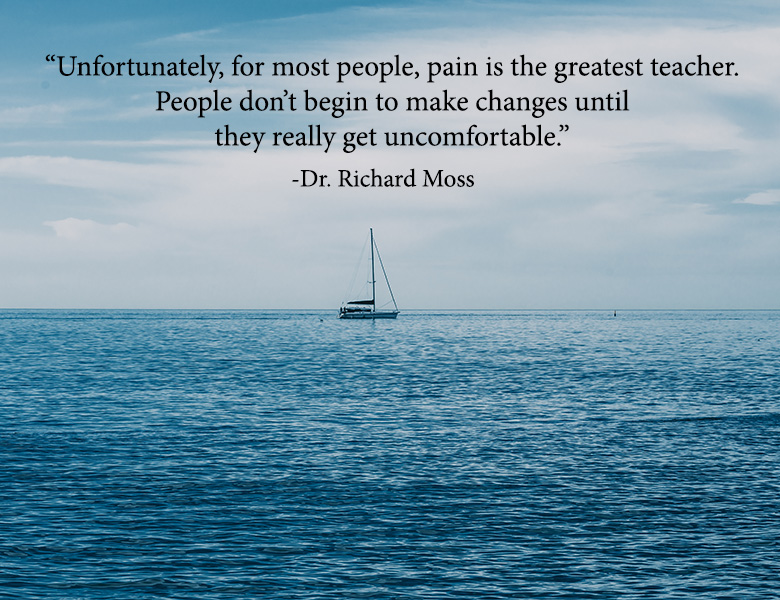4 Steps to Breaking the Addiction to Being Comfortable
By Robert E. Staub, Best selling author of The 7 Acts of Courage
Everyone in our society seems to be striving to achieve something. To get to some desired destination – wealth, business success, published author, recognized expert, happily engaged with a loving partner, being slim and trim – you name it, someone desires it.
Yet, many are on a slow boat going nowhere because of a huge barrier preventing them from getting close to achieving their desired goal(s). In physics this barrier is called “inertia.” In life, this means that the status quo tends to remain the status quo unless some other force “acts” upon it.
In other words, you get into a particular groove in how you are living that turns into a rut unless other forces or actions force you into new patterns of thinking, perceiving and acting.
The challenge is this:
Humans tend to fall in love, or at least deep “like,” with COMFORT. People may feel stuck or even somewhat unhappy in their rut, but it’s velvet-lined in familiarity and safe in its predictability. This comfort zone becomes a trap for all too many people. Breaking free requires the Courage to Learn and Grow, and a willingness to actively step into the unknown, entertaining ambiguity and giving up any need to be right.

There is an old English saying, “If you want the fruit of the tree you have to go out on a limb.” This means deliberately making yourself uncomfortable by taking the risk of falling, of actually engaging in behaviors that feel difficult, challenging and even, at times, “unnatural.”
To overcome inertia you have to expend energy, effort, time, and actively step into discomfort.
For example, if you want to be slim and trim, you will need to let yourself feel hunger and stay with that feeling of hunger several times a day for weeks, and even months on end. If you are unwilling to let yourself feel hunger, if your addiction to the comfortable, familiar feeling of a full stomach prevails, you will not be successful.
In addition, letting yourself feel hungry is not enough. You will need to get some exercise in. This means stepping out of the comfort zone of current activities, working up a sweat, and being uncomfortable.
If you want to advance your career and step up to a higher level of functioning and status, yet are not willing to say “no” to old, familiar ways of working and risk new behavior, then you are likely to stay put. The truth, is that if you do not exercise the Courage to Learn and Grow, if you are not willing to step out of your comfort-zone, then your comfort zone might become a prison cell that prevents you from realizing your aspirations or dreams.

There are 4 key actions you can take to break out of the addiction to comfort trap.
1.) Commit to cultivating the Courage to Learn and Grow.
Stop and reflect on the following questions: “Am I willing to truly be uncomfortable, to get out of what feels familiar and safe, to step into the unknown, in order to achieve what I want?”
“Where does my attachment, or even addiction, to being comfortable show up most when I start to go after what I want and I am stopping myself, making excuses, avoiding or procrastinating?”
“Am I willing to not know and to begin again?”
2. Write down, commit to paper, the major goals that you wish to accomplish.
Then read through the list and put beside it a compelling reason to achieve it. If you do not have a compelling reason then cross it off your list. With the ones left, ask yourself, “Am I willing to commit to making this goal a reality? Am I willing to be really uncomfortable to make it so?”
Only go forward on the goal(s) that have a compelling reason and that you are willing to step into active discomfort to achieve.
3. Make a list of the things you will need to do to achieve one of your major goals.
Notice each activity that is a stretch for you, the things that will make you uncomfortable, and that are really not normal for you to do. Look at the activity or action that makes you most uncomfortable and find a model of excellence. Ask, “Whom do I know of (personally or through story or the media) who is really accomplished at that kind of action or activity?”
Write down the name and then read about that person, watch him or her in action and study HOW she or he talks, moves, works and presents her/himself.
4. Practice the most uncomfortable behavior first.
Act on what is most challenging for you by modeling yourself after the person(s) you identified in step 3. Notice every time an excuse or some other form of resistance pops up trying to get you to step back into your old, familiar comfort zone. Think then of your model of excellence, what he or she would say or do at that moment, and follow through on that, not the old pattern.
Be patient and persistent with yourself. Pause and reflect often on your compelling reasons in step 2 above.
If you persist in these steps…
Within a matter of twelve to fourteen weeks, you will discover that your addiction to comfort is now only a preference and that it no longer has the power to keep you from stepping out to achieve what you wish.

The other interesting phenomenon is that what used to be highly uncomfortable is now only somewhat challenging to you. Your comfort zone has expanded, and your capacity and abilities have become bigger! After all, it’s OK to like being comfortable. We simply do not want it to be trap.
And keep in mind that all new behavior, when practiced long enough, becomes much more comfortable. Thus, exercising the Courage to Learn and Grow, we keep expanding our zone of comfort, becoming more flexible, open, adaptable and capable in all aspects of our lives.
Are you willing to be uncomfortable enough to truly learn and grow?

